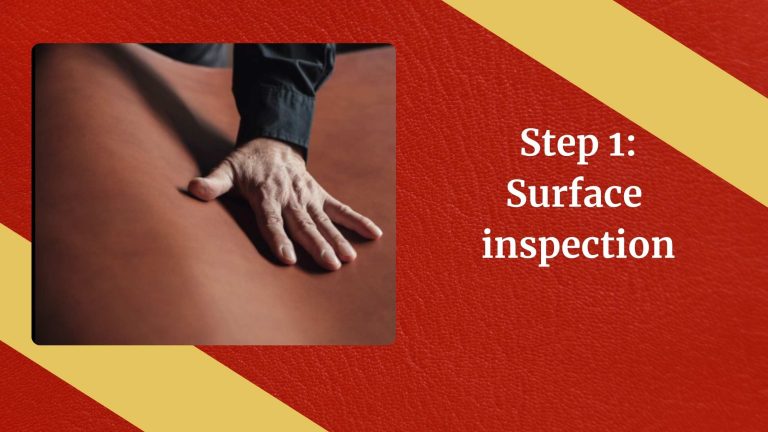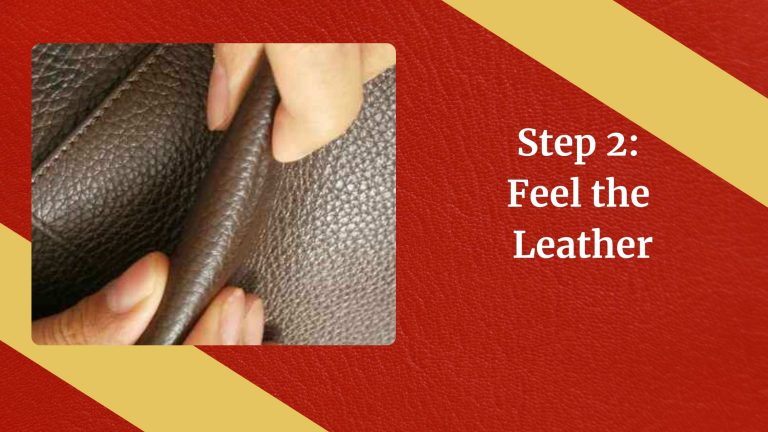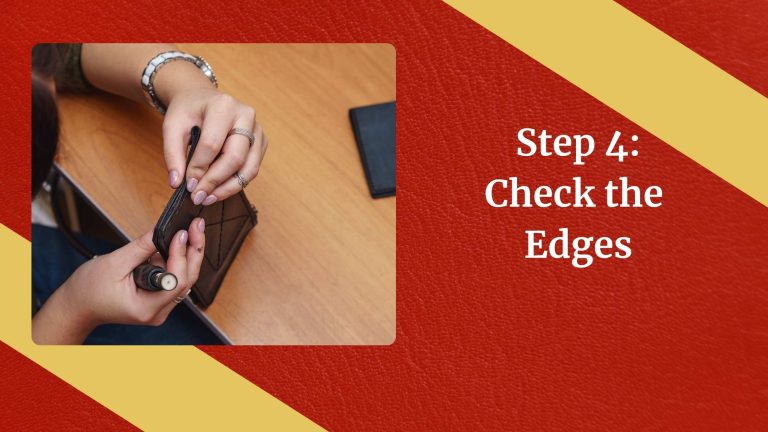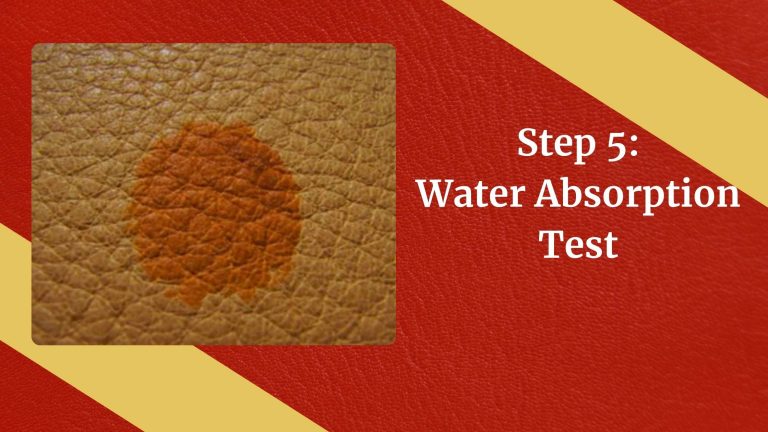Whether you are a regular shopper of leather products or a person who is willing to start or expand their business in the leather industry, knowing leather quality is paramount.
Each leather type has unique characteristics and varies in quality.
High-quality leather products would be more durable and have an aesthetic appearance. While low-quality leather products would be more affordable.
In this blog, we will be sharing the 5-step process to check leather quality to help you purchase the best leather products for yourself or your customers.
Curious to learn more?
Continue reading for all the important info regarding leather quality!

Step 1: Inspect the Surface
High-quality leather is real leather, as it has natural markings and imperfections from the animal skin and unique textures. These features on the leather highlight the authenticity of the leather.
Low-quality leather or synthetic leather has a uniform surface, and their patterns are often repetitive, failing to replicate the textures and imperfections of real leather.
How to Differentiate Between Genuine and Synthetic Leather?
Aspect | Genuine Leather | Synthetic Leather |
Grain Pattern | Unique and natural grain pattern. | Uniform and artificial grain pattern. |
Surface Feel | Warm, supple, and flexible. | Cold, stiff, and less flexible. |
Smell | Rich and earthy from the tanning process | Chemical or plastic-like odor |
Flexibility | Molds to shape, becomes softer with use | Stiff, does not conform easily |
Water Absorption | Absorbs moisture, darkens when wet | Repels water and beads on the surface. |
Burn Test | Smells like burning hair, leaves ash | Chemical odor melts or forms a hard residue. |
Price | More expensive | Cheaper and more budget-friendly |

Step 2: Feel the Leather
To feel how soft and flexible leather is, real leather should feel very soft and pliable. It should be easy to bend and shape with your hands. When you press on it, it should gently give and then return to its original shape, showing that it’s high-quality and not too stiff.
Signs of High-Quality Leather Through Touch
- Softness and Smoothness: High-quality leather is soft and smooth to the touch, with a supple and luxurious feel.
- Grain Pattern: Real leather often has a natural, irregular grain pattern that feels unique and distinct.
- Temperature Regulation: Quality leather often feels warm and adapts to the temperature of your body.
- Flexibility: High-quality leather is flexible and able to bend without cracking or losing its shape.
- Even Texture: The texture of real leather is consistent and even across the surface.

Step 3: Smell the Leather
Real leather has a rich, earthy, and somewhat sweet smell. This is due to the natural oils and tanning processes used. The scent of real leather can vary depending on the type of animal hide and the tanning method.
How To Identify Chemical Odors in Low-Quality Leather?
- Low-quality or synthetic leathers have strong, chemical odors like plastic, rubber, or even astringent solvents. This can be due to the use of synthetic dyes, glues, or finishing agents.
- Real leather’s scent is more enduring and less likely to dissipate quickly. If the smell fades rapidly, it could indicate low-quality or synthetic leather.

Step 4: Check the Edges
Here is a difference between finished edges and unfinished edges that will help you understand leather quality:
Aspect | Finished Edges | Unfinished Edges |
Appearance | Smooth, even, polished | Raw, rough, uneven |
Texture | Sleek, smooth | Rough, fibrous |
Edge Treatment | Coated with dyes or sealants | Untreated, natural |
Durability | More durable and resistant | Less durable, prone to wear |
Leather Type | Full-grain or top-grain | Often lower-quality or split leather |
What Edge Quality Can Reveal About Leather Type?
You would be surprised to know, but even the quality of edges can reveal about the leather type:
1) Finish and Smoothness:
The edges of high-quality leather are smooth and finished. They are free from any rough surface. Synthetic leather might have uneven or rough edges.
2) Thickness and Density:
High-quality leather like full-grain has thicker and more well-defined edges, which are missing in low-quality leather like bonded leather or corrected leather.
3) Durability:
The edges of the real leather are highly durable and can withstand wear and tear easily. Low-grade leather products can get peeled on the edges quickly.

Step 5: Test for Water Absorption
Through a water absorption test, you can check the quality and durability of the leather.
Why Water Absorption Matters for Leather Durability?
1) Durability:
If leather is placed in the water and it becomes soft and starts to lose its shape, it’s a sign of low-quality leather. Excess water absorption weakens the leather fiber, which can result in quick wear and tear of the leather.
2) Protection:
Leather products like bags and shoes are regularly exposed to the environment. High-quality leather would easily withstand the heat, rain, or spills.
3) Maintenance:
Leather that absorbs water quickly may require more frequent maintenance to keep it in good condition. Products with lower water absorption generally need less upkeep and are more practical for daily use.
Simple Test for Water Absorption
Perform this simple water absorption test to assess the quality of leather.
- Take a small piece of leather sample. Make sure the sample is clean and dry before you start the water absorption test.
- Measure and record the weight of sample leather before starting the test.
- Soak the sample leather in the water container for around 1-2 hours.
- After the time is over, remove the sample leather from the water and shake off the extra water.
- Now measure the weight of the sample leather again. (wet weight)
- Subtract the dry weight from the wet weight to find the amount of water absorbed. You can use this formula:
Water Absorption (%) = [(Final Weight−Initial Weight)/Initial Weight] × 100
Interpretation of Final Result
- Low Absorption: It means the leather has good water resistance and is more durable.
- High Absorption: If the water absorption is high, the leather is less durable and more prone to damage from moisture.
Additional Tips for Assessing Leather Quality
Leather is of different types, and they are mainly categorized into high-quality leather and low-quality leather.
1. Full-Grain Leather:
They are the highest quality leather and come from the top layer of hides. They have natural grain, imperfections, and variations in texture. They are highly durable and develop patina as leather ages.
2. Top-Grain Leather:
Top-grain leather also falls under high-quality leather, but their quality is a little less than full-grain leather. Their surface is buffed and sanded to remove imperfections and give them a uniform appearance.
3. Genuine Leather:
Genuine leather is low-quality leather and is made from the lower layer of the hides. They are often mixed with synthetic to mimic the appearance of high-quality leather products. These leathers are less durable.
4. Bonded Leather:
Bonded leather is made from leftover scraps from real leather. These scraps are collected and bonded together using adhesives. These leathers are cheaper, less durable, and lack natural leather features.
Common Pitfalls to Avoid
- Not paying attention to the natural grain of the leather. Full-grain leather should have visible, natural variations.
- Not considering the smell of the leather. High-quality leather should have a rich, natural scent.
- Not feeling the leather’s texture. Quality leather should feel soft, supple, and slightly elastic.
- Not checking the quality of stitching.
- Overlooking how the edges are finished.
The Bottom Line
Leather products have high demand among audiences of all types. They are purchased and embraced by people either every day or on special occasions. But what matters the most while purchasing these products is their quality.
Leather quality decides the longevity of the leather. Products made from high-quality materials promise durability, while low-quality leather products wear out quickly during regular use. That’s why it is important to implement the above-mentioned 5 steps to check the quality of leather.
So, next time when you shop for leather goods, just remember to check leather to see whether your favorite leather item passes all these 5 steps.
